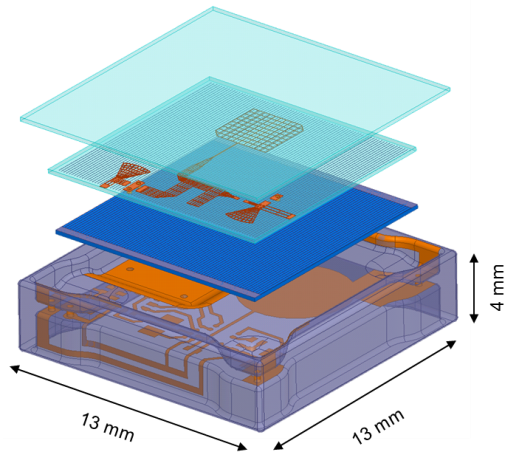SFB 653 - L2: Opto electronic integration of HF communication system for gentelligent components

| E-Mail: | christoph.vonderahe@ita.uni-hannover.de |
| Year: | 2011 |
| Date: | 30-06-17 |
| Funding: | DFG |
| Duration: | 07/2005 - 06/2017 |
| Is Finished: | yes |
| Further information | http://www.sfb653.uni-hannover.de |
Figure 1: Transponder module with MID housing, solar cell, antenna structure and protective glass.
Using high-frequency technology, information can be transferred without contact to an object, be locally saved there, and if required by retrieved or adapted. This technology is the basis for Radio Frequency Identification, or RFID in short. Corresponding communication modules – referred to as transponder, tag or smart label, depending on the respective use – are so far mounted on surfaces of objects or close to the surface. When implementing this approach, a particular challenge arises with metal objects, since they do not allow the penetration of high-frequency electromagnetic fields due to the reflective effect of metals.
The aim of the L2 sub-project is to integrate the entire communication electronics (high frequency module, microcontrollers and memory) into the interior of a workpiece, to connect these with the surface that acts as a transmitting and receiving antenna for the signal-carrying electromagnetic waves, using a dimensioned waveguide. The limited availability of the chip set, the desire for small geometric dimensions, as well as the restrictions with regards to license-free frequency bands is leading to system designs and research in the frequency range up to 24 GHz. A major scientific issue here is the provision of power for the integrated circuits. Therefore different methods of “energy harvesting”, i.e. the collection of electrical energy from the environment, are being examined within the framework of the sub-project. In addition, the construction of integrated circuitry is being designed with regard to a possible low energy consumption.
Due to its many and varied challenges across various faculties, the sub-project L2 is being worked on by the Institute for High Frequency Technology and Radio Systems of the Faculty of Electrical Engineering and Informatics, and the Institute for Transportation and Automation Engineering of the Faculty of Mechanical Engineering.




















